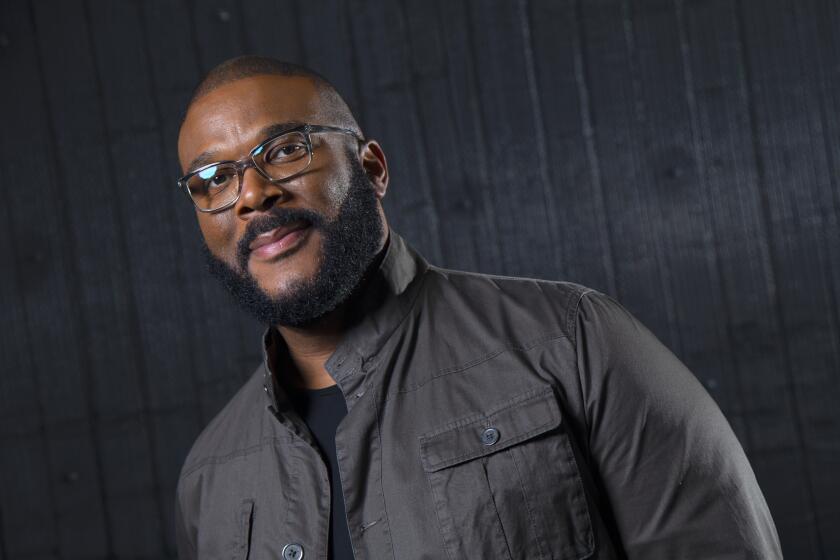ART REVIEW : Heartfield’s Powerful Attack on Elitism, Society’s Ills : The works of the Nazi-era Berlin artist, on view at LACMA, prove it is possible to make real art about ephemeral events in a flimsy medium.
- Share via
The Berlin Wall fell like the first domino in a delicately balanced row. Those flimsy piers held up Cold War culture. Everything slumped into surprisingly orderly chaos: the Soviet Union, barriers between old hatreds, the world’s economy. The art market went into eclipse. Artists were once again bitter and confused about their weird social role as spiritual seekers obliged to make luxury items for the limousine set. What to do?
Well, it’s a bad disaster indeed that doesn’t reveal some clue to rebuilding. In this case it’s a Nazi-era Berlin artist, John Heartfield, whose first decent retrospective is on view at the Los Angeles County Museum of Art thanks to the falling of the hated wall.
He was born Helmut Herzfeld in a Berlin suburb in 1891. When he was 8, his parents abandoned their children. Helmut grew up anyway--angry, diminutive, street-smart and art-wise. During World War I, he and Berlin Dadaist George Grosz anglicized their names to protest the demonizing of the British. They joined the Communist Party.
Postwar, Heartfield attacked art’s elitism and society’s ills by pioneering photomontage. He used it as a social weapon in book jackets, posters, theater design and, mainly, a series of magazines run by his brother, the party or fellow guerrillas. He attacked the Nazis with such potent sting that he had to duck out--to the Soviet Union, then Prague, Paris and London--censors and the SS snapping at his heels. Like Charlie Chaplin, he did the unforgivable. He made the Fuhrer look like a fool.
In 1938 he made safe haven in England, so exhausted that on his first morning friends had to break down the bedroom door to wake him. He was finally repatriated to East Germany in 1950 with help from his colleague Bertolt Brecht, but that didn’t end his troubles. Comrades suspected him of collaborating and found his art politically incorrect. Nervous West Germany demoted him to a mere propagandist. They’d eased up on him by the time he died in 1968, but his work languished in the Academie der Kunste, Altes Museum, Berlin, until 1991.
The present revelatory retrospective was organized for international tour by the Museum of Modern Art, overseen here by LACMA coordinator of curatorial affairs Stephanie Barron. The installation--dramatically designed by the architectural firm Co-Op Himmelblau--includes more than 100 works.
Part of the fascination of this exhibition is a virtually unprecedented showing of the artist’s original paste-ups. The deftness with which he juxtaposed and airbrushed tones to dramatize reproduction goes beyond mere skill into the realm of the painter’s touch.
Even more compelling is the astonishing aptness of the issues raised by Heartfield’s work. Contemporary art is awash in social politics. Its detractors say that’s the problem--it’s too timely and too thin. Its defenders snap back that the detractors are a bunch of elitist dinosaurs whose concern with quality is just a cover-up for “I say what’s good around here.”
This affecting exhibition proves everybody’s negatives are wrong, including the artist’s. The show proves you can make real art about ephemeral events in a flimsy medium. Two things are required: The event has to be universalized and the imagery has to be unforgettable. Heartfield did both things superbly.
The immediate point of “The Meaning of Geneva” may be forgotten, but it’s clear what’s happened when we see a white dove impaled on a bayonet in front of a government building. It’s hard to mistake the meaning of a cathedral fashioned of cannon shells or a ship of state whose sails are food stamps. The world is unlikely to forget Hitler, but Heartfield leaves a graphic reminder that when the Fuhrer gave the Nazi salute and ranted that “millions are behind me,” he was reaching for the bribes he took from his fascist backers.
Heartfield thought like a political cartoonist--a great one like Daumier and Thomas Nast. But he sensed, anticipating Marshall McLuhan, that the medium was the message and that the apt one for him was photography. It feels modern, immediate and truthful, although it can lie like a horse-trader. Thus, photos of Goebbels and Goering, looking like the venal slobs they were, are more convincing than a caricaturist’s exaggeration. Heartfield’s image of a man crucified on a swastika was certainly staged, but it has more impact than the sculpted medieval torture wheel next to it.
The artist’s guts in going publicly head-on with one of the most vicious regimes in human history is awesomely admirable. He left an acid legacy of challenge to today’s disenchanted, gallery-closeted, political dilettante yuppie artists. Take it out there to the people where you have to be really good to be remembered. For Heartfield, the reward of success is a place in the histories of both art and heart.
*Los Angeles County Museum of Art, 5905 Wilshire Blvd., (213) 857-6111, through Jan. 2. Closed Mondays and Tuesdays.
More to Read
The biggest entertainment stories
Get our big stories about Hollywood, film, television, music, arts, culture and more right in your inbox as soon as they publish.
You may occasionally receive promotional content from the Los Angeles Times.










